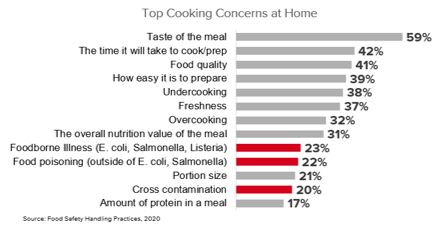The research was conducted using an online quantitative survey in April 2020 among 1,000 consumers. The sample or respondents was balanced to census on age, region, and gender. Those surveyed had to eat beef and have partial or full responsibility when cooking. The objective of the research was to gain knowledge of consumer food safety interest, perception, and practice.
Results showed, in the context of other topics, interest in food safety is lower among consumers. Specifically, 32% of consumers are interested in learning about food safety handling practices, whereas roughly 60% are interested in other food-related aspects such as recipes and cooking techniques.2 Additionally, consumers may express a variety of concerns about cooking a meal at home, food safety concerns fall toward the bottom. Specifically, foodborne illness and food poisoning is only concerning to 20% of consumers. Like consumer’s protein consideration noted above, things like taste, preparation, and food quality are of greater concern.

The research also shows that only 15% of consumers think they are very or extremely likely to get sick from food cooked at home—compared to roughly 25% at various types of restaurants. So, while food safety is of the utmost concern to the beef industry, it’s less relevant to consumers cooking at home. Why do consumers feel this way? A lack of interest and concern for food safety isn’t just because of the topic itself, rather consumers already feel safe about the food they buy at the grocery store and cook at home. Further, consumers place more responsibility on the supply chain for ensuring food safety rather than themselves. Yet, not all of them report following meat safety procedures. For example, 81% report washing hands after handling meat, but 42% still report washing meat.

Specific to beef, 90% of consumers feel the beef they eat from the grocery store is safe. This number is comparable to the percentage of consumers who feel safe about fresh fruits and vegetables. Most consumers also report storing leftover meat within the recommended amount of days—storing ground beef slightly longer than steak. However, though interest and concern are lower some potential exists for speaking to consumers about food safety. When asked directly about what practices they’re using at home, most consumers are washing hands before and after handling meat and sanitizing surfaces, but not all. And in terms of other practices, 76% of consumers claim to use a thermometer when cooking, but only 12% do so regularly. In consumer verbatims for why they use a thermometer, only 6% explicitly mention food safety:
“Afraid the temperature is too hot and dangerous.”
“To see when the water is hot.”
– Direct consumer quotes
To encourage consumers to adopt more food safety procedures and improve their perceptions of food safety, using online resources is expected. The research highlights that consumers would like to hear from the USDA and FDA and learn through cooking shows and blogs. However, for consumers to adopt food safety practices in their own homes, showing how the methods can also improve the protein’s taste and quality, and be done quickly, is critical.
References
-
1. National Cattlemen’s Beef Association, Consumer Beef Tracker, 2018-2020
- 2. National Cattlemen’s Beef Association, Beef Safety Practices Survey, 2020